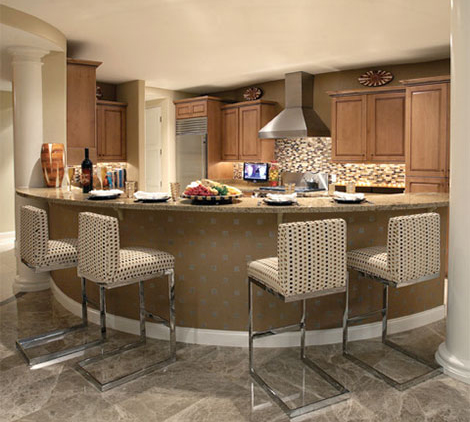When the Bendts enter their spacious residence, they breathe deeply and look outside and inside. “Space is the ultimate luxury for a New Yorker, and that is why we kept our Biltmore place open and uncluttered,” Sonia says. In particular, they like the high ceilings and the wall-to-wall glass doors because these elements are conducive to openness—a fitting reminder that they are not in New York City anymore.
“Everyone who has walked into our home loves the airiness of the space and the open-plan layout,” Sonia says, who returned to school for interior design because real estate clients of hers kept asking how they should coordinate their homes—even after working with professional interior designers.
In the early morning for coffee, or late in the evening for wine, the Bendts sit in front of the large bay window looking south over the golf course. For conversation with friends, they usually choose the living room—especially in the cool of the desert nights. “I love turning the gas fireplace on,” Sonia says. And, for entertaining, everyone is attracted to the open kitchen with its large wrap-around bar and four contemporary Brueton stools finished in a square-motif material from Stark Fabrics.
Contributing to this spaciousness is the selection and placement of the furniture and accessories. Modernist without being cold, the interior relies on individually selected pieces from classic 20th century masters as well as contemporary pieces from New York City and Arizona artists and designers.
Sonia’s cues come from the Bauhaus and international styles and Wrightian organicism. These influences translate into clarity, simplicity, sculptural lines and individual pieces coordinating with the whole. Her historical mentors are Ludwig Mies van der Rohe and Florence Knoll. “My attention to detail, clean lines and fondness of modern classic furniture came about as a result of studying the classics and learning, indeed, that ‘less is more,’” she explains, referring to the famous Mies dictum. “After studying Mies’s work and loving his ideas, I was motivated.”
She adds: “I am not a fan of cluttered spaces and believe that if you invest in the best materials, furniture and clean lines, you will be able to live with your home for a very long time.” At the same time, Sonia coordinates every piece—art, fabric, furniture, even flowers. “To create a completely harmonious environment, everything has to be thought out,” she says.
In the living room, for example, a three-seat tan Florence Knoll sofa and two white-leather Ludwig Mies van der Rohe Barcelona chairs and two benches surround a Mies-designed Barcelona “X” glass-and-polished-steel table, so called because of the surface framing. On the open side is the gas-fired stone fireplace, which delivers the warmth the Bendts so enjoy.
“I love the Barcelona chairs, which have been described as ‘art you can sit in,’” Sonia says. Modern classics, the chairs and the table were custom-designed in 1929 for the German Pavilion at the World Exposition in Barcelona; the king and queen of Spain sat in the originals during the event. On a chrome-plated steel frame that “floats” the chair cushion, the iconic chair is a product of Mies’s years at the Bauhaus, which the Nazis forced to close in 1933. The Mies pieces are all authorized and manufactured by Knoll. “I chose them because I love the clean elegant lines,” she says.
